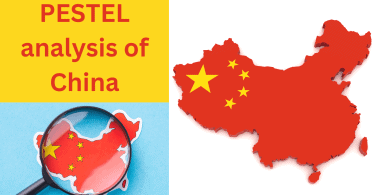In 2024, Canadian Tire remains one of Canada’s most iconic and enduring retail brands, known for its vast range of automotive, hardware, sports, and leisure products.
Understanding the external factors influencing its operations is crucial as the company adapts to an ever-evolving business environment.
A detailed PESTEL analysis of Canadian Tire offers valuable insights into how political, economic, social, technological, environmental, and legal factors shape its strategic decisions.
This analysis will explore the company’s challenges and opportunities in adapting to these external forces in an increasingly competitive market.
PESTEL analysis of Canadian Tire
We now turn to the results of Canadian Tire PESTEL analysis:
Political factors
Government Regulations and Tax Policies
Government policies related to taxation, labor laws, and corporate regulations can significantly impact Canadian Tire’s operational costs and profitability.
If corporate taxes increase or stricter regulations are introduced, Canadian Tire may face higher compliance costs or reduced profit margins.
As of 2023, the Canadian federal corporate tax rate is 15%, and Ontario adds 11.5%, bringing the total corporate tax rate to 26.5%. Changes to these rates can affect the company’s financial planning.
For example, in 2021, the Canadian government introduced a 3% digital services tax aimed at large technology companies. Canadian Tire’s online business could face increased operational costs if similar levies were extended to large retail players or e-commerce operations.
Trade Agreements and Tariffs
Canada’s participation in international trade agreements like the USMCA (United States-Mexico-Canada Agreement) directly impacts Canadian Tire’s supply chain and cost structures, particularly when importing goods from the U.S. or overseas.
Favorable trade agreements reduce tariffs and allow for smoother cross-border transactions, which helps Canadian Tire keep costs low for imported goods.
Under USMCA, implemented in July 2020, Canadian Tire benefits from tariff-free trade on most goods imported from the U.S. and Mexico.
However, ongoing discussions about U.S.-Canada relations, particularly concerning the automotive and aluminum industries, could lead to higher tariffs on certain products, increasing Canadian Tire’s costs.
For instance, the U.S.-Canada softwood lumber dispute in 2022-2023 led to duties on Canadian lumber exports, which raised material costs for hardware retailers like Canadian Tire.
Government Stimulus and Economic Policies
Federal and provincial government stimulus and economic recovery policies, especially after the pandemic, can directly impact consumer spending, which is critical for Canadian Tire’s revenue.
Stimulus packages tend to boost consumer confidence and spending, benefiting retail sales. The Canadian government’s pandemic recovery support programs, such as the Canada Emergency Wage Subsidy (CEWS) and the $101 billion recovery plan, helped stabilize the economy in 2021 and 2022.
As a result, retail environments strengthened in 2023, contributing to a 4.7% year-over-year increase in Canadian Tire’s sales as of Q3 2023.
Moreover, with the federal government focusing on infrastructure development and green energy investments through its 2024 budget plan, Canadian Tire’s automotive and home improvement sectors could experience further growth due to rising consumer demand for these products.
Environmental Regulations and Sustainability Initiatives
Political pressure for sustainable business practices is growing, and Canadian Tire must adapt to evolving environmental regulations on carbon emissions, recycling, and product sourcing.
Compliance with stricter environmental regulations can increase operating costs and present opportunities for green product lines. The Canadian government’s carbon pricing, introduced in 2019, continues to rise, affecting companies that rely on fossil fuels for their supply chain or logistics.
In 2023, the carbon price reached CAD 65 per ton and is expected to rise to CAD 170 per ton by 2030. Canadian Tire has responded by investing in sustainable products and packaging to align with these regulations.
For example, Canada’s ban on single-use plastics by 2023 directly impacted Canadian Tire’s product lines, pushing the company to innovate with eco-friendly alternatives.
Political Stability and Public Infrastructure Investments
Canada’s stable political environment and ongoing public infrastructure investments support business growth, particularly in retail, logistics, and e-commerce.
Political stability ensures a predictable business environment, while investments in infrastructure help improve the efficiency of Canadian Tire’s supply chain.
In the 2023 Global Peace Index, Canada ranked high in political stability, contributing to a favorable business climate. Additionally, the Canadian government recently announced a CAD 15 billion investment in public infrastructure, including transportation networks, over the next decade.
These developments directly benefit retail logistics and e-commerce operations. Expanding public transit and highway systems, such as the Ontario Line project in Toronto, will improve access to Canadian Tire’s retail stores and distribution centers, boosting customer convenience and reducing transportation costs.
Labor Laws and Minimum Wage Policies
Changes in labor laws, particularly minimum wage increases, can directly impact Canadian Tire’s labor costs. However, higher minimum wages can also increase consumer spending by boosting the purchasing power of workers across the economy.
In 2023, the minimum wage in Ontario rose to CAD 16.55 per hour, up from CAD 15.50 in 2022. With over 58,000 employees, Canadian Tire faces significant cost implications from such wage hikes.
Similar increases across other provinces could further impact its profitability. Labor shortages and rising wages have led many retail companies to invest more in automation and digital solutions.
Canadian Tire has followed suit by integrating more self-checkout systems and warehouse automation to reduce its reliance on manual labor.
Economic factors
Economic Growth and Consumer Spending
The overall economic growth of Canada plays a major role in influencing Canadian Tire’s sales and performance. When the economy grows, employment rates increase and consumers tend to have more disposable income, boosting spending on goods and services.
In recent years, Canada has seen fluctuations in its economic growth due to global factors like the pandemic and inflationary pressures. As of 2023, the Canadian economy has experienced moderate growth, with a GDP increase of 1.5%.
Consumer spending remains relatively steady, though there are concerns about rising inflation, which reached 3.3% in mid-2023. This steady economic activity supports Canadian Tire’s revenue growth, particularly in its automotive, home improvement, and leisure segments.
However, inflationary pressures and slower growth in 2024 could dampen consumer spending, affecting sales.
Inflation Rates and Purchasing Power
Inflation directly affects Canadian Tire’s costs and the purchasing power of its customers. When inflation is high, the cost of goods rises, reducing consumer demand, especially for non-essential products.
As of 2023, Canada’s inflation rate stood at 3.3%, down from its peak of 8.1% in mid-2022. The Bank of Canada has been working to bring inflation under control by raising interest rates, which could impact borrowing costs for Canadian Tire and its customers.
Inflation also impacts the cost of raw materials and shipping, leading to higher product prices. Canadian Tire has been forced to adjust its pricing strategy to protect margins.
However, too much price adjustment could discourage consumers from purchasing non-essential goods, particularly in discretionary categories like sports equipment or recreational items.
Interest Rates and Borrowing Costs
The cost of borrowing is a significant economic factor for Canadian Tire, especially as it invests in new stores, distribution centers, or infrastructure upgrades.
In 2023, the Bank of Canada increased its key interest rate to 5% to combat inflation, making borrowing more expensive for businesses and consumers.
This rate hike has implications for Canadian Tire’s expansion plans, as higher interest rates increase the cost of financing new projects or acquisitions.
It also impacts consumer behavior, as higher interest rates typically reduce spending on big-ticket items that require financing, such as home improvement products or automotive parts.
Rising rates could damper credit-based purchases, which are common in retail environments. For Canadian Tire, which offers financial services such as credit cards, this could affect the demand for its financial products, as consumers may avoid taking on additional debt.
Exchange Rates and Import Costs
Canadian Tire imports a significant portion of its products from countries like the U.S., China, and other international markets. As a result, fluctuations in the Canadian dollar’s exchange rate against major currencies, particularly the U.S. dollar, can affect its import costs and pricing strategy.
In 2023, the Canadian dollar averaged around 0.74 USD, a weaker position than previous years. A weaker Canadian dollar increases the cost of imported goods, which can squeeze profit margins if Canadian Tire cannot pass these costs on to consumers.
This is especially important for imported categories like automotive parts and outdoor equipment, a significant portion of Canadian Tire’s inventory.
The weaker currency also means that sourcing from international suppliers is more expensive, and Canadian Tire must carefully manage its foreign exchange risk to mitigate any negative financial impact.
Employment and Wage Levels
Canada’s labor market conditions also directly impact Canadian Tire’s operations. When employment levels are high and wages increase, consumer spending typically rises, benefiting retail businesses.
As of 2023, Canada’s unemployment rate is 5.5%, indicating a strong labor market. However, wage growth is becoming a double-edged sword for retailers like Canadian Tire.
On one hand, higher wages can increase consumer purchasing power, boosting demand for products. On the other hand, rising labor costs add to Canadian Tire’s operating expenses, especially with minimum wage increases in several provinces.
For example, Ontario’s minimum wage rose to CAD 16.55 per hour in 2023. With thousands of employees across Canada, these increases impact Canadian Tire’s bottom line, pushing the company to explore efficiencies in labor management, such as automated checkout systems or streamlining store operations.
Fuel Prices and Transportation Costs
As a major retailer that relies on an extensive supply chain network, fuel prices are a critical economic factor for Canadian Tire. Fluctuations in oil prices affect the cost of transporting goods from suppliers to distribution centers and stores across Canada.
In 2023, global fuel prices saw some volatility, with the average price of gasoline in Canada hovering around CAD 1.70 per liter. Rising fuel prices increase logistics and delivery costs, which Canadian Tire must either absorb or pass on to customers through higher product prices.
With e-commerce growing as a crucial part of Canadian Tire’s business, delivery costs have become even more significant. Higher transportation costs impact the pricing of goods and challenge the profitability of Canadian Tire’s online sales operations, where competitive pricing and free delivery services are key differentiators.
Economic Policy and Fiscal Measures
The economic policies implemented by the Canadian government, particularly about taxation, business incentives, and fiscal stimulus, can greatly affect Canadian Tire’s overall business environment.
In response to the pandemic and subsequent economic challenges, the Canadian government has introduced various stimulus measures and fiscal policies to support businesses and boost economic recovery.
In 2023, the federal government’s budget included investments in infrastructure, green technology, and innovation, which can indirectly benefit Canadian Tire by increasing demand for products related to home improvement, automotive tools, and sustainable energy solutions.
However, ongoing fiscal tightening, especially to control inflation, might limit the extent of future stimulus measures, which could slow consumer spending and impact the retail sector.
Social factors
Changing Consumer Preferences and Lifestyles
One of the most significant social factors affecting Canadian Tire is the shift in consumer preferences and lifestyles.
In recent years, there has been a growing focus on health, wellness, and sustainability among Canadian consumers, leading to increased demand for products related to fitness, outdoor activities, and eco-friendly options.
Canadian Tire has adapted to this trend by expanding its offerings in sporting goods, home fitness equipment, and sustainable products.
As of 2023, the outdoor recreation sector in Canada continues to grow, with more people participating in activities like cycling, camping, and hiking.
Canadian Tire’s focus on these areas positions it well to capture this demand. However, maintaining this alignment with changing consumer preferences will be crucial as trends like remote work and home-based fitness evolve.
Demographic Shifts
Canada’s population demographics are constantly growing, and these shifts directly impact Canadian Tire’s customer base. One key demographic trend is the aging population.
By 2024, nearly one in four Canadians will be aged 65 or older, according to Statistics Canada. This aging demographic brings both challenges and opportunities for Canadian Tire.
Older consumers may prioritize convenience and health-related products, leading to potential growth in categories such as home improvement for accessibility, health and wellness products, and automotive services.
On the other hand, younger demographics, especially millennials and Generation Z, are increasingly tech-savvy and prefer online shopping experiences.
Canadian Tire has responded by enhancing its digital offerings and focusing on e-commerce to appeal to these younger consumers.
Understanding and adapting to the needs of different age groups will be essential to maintaining customer loyalty across generations.
Urbanization and Regional Differences
The ongoing trend of urbanization in Canada is another social factor affecting Canadian Tire. As more Canadians move to urban areas, the demand for different types of products can shift.
For instance, consumers in urban areas may prioritize smaller living spaces and transportation options that suit city life, such as bicycles or compact cars, rather than larger tools and equipment.
In contrast, rural and suburban consumers may have a greater demand for home improvement products, outdoor gear, and automotive parts. Canadian Tire must balance its product mix to cater to these regional needs.
According to the 2021 Census, 73% of Canadians live in urban areas, which is expected to rise. As a result, Canadian Tire’s ability to meet the diverse needs of both urban and rural consumers will play a crucial role in its future growth.
Health and Safety Concerns
Consumer concerns around health and safety have been heightened since the COVID-19 pandemic. Shoppers are now more aware of the importance of hygiene, safe shopping environments, and wellness-related products.
Canadian Tire has responded by enhancing its in-store health and safety protocols, including increased sanitation, social distancing, and contactless payment options.
This has built trust with customers, especially during peak pandemic periods. Additionally, the demand for products that promote personal health, such as home exercise equipment, air purifiers, and wellness gadgets, has grown significantly.
The Canadian health and wellness industry was valued at over CAD 9 billion in 2022, and this trend is expected to continue.
Canadian Tire’s success in capitalizing on this trend will depend on its ability to stock and promote the right health-related products while maintaining high in-store and online safety standards.
Focus on Sustainability and Ethical Consumption
Canadian consumers have a growing awareness and demand for sustainability, especially as environmental concerns become more mainstream.
Many shoppers now support brands committed to ethical sourcing, environmentally friendly products, and sustainable practices.
Canadian Tire has recognized this shift by investing in sustainable product lines and implementing environmentally responsible initiatives, such as reducing waste and improving energy efficiency.
The Canadian government has also enforced stricter environmental regulations aligning with consumer expectations for companies to adopt greener practices.
As of 2023, over 80% of Canadians stated they were willing to pay more for sustainable products, according to a Retail Council of Canada survey.
Canadian Tire’s ability to continue delivering on sustainability promises will be crucial in maintaining its competitive edge in the market.
Rise of Digital Shopping and E-Commerce
The rise of e-commerce and digital shopping has significantly altered consumer behavior in Canada. The convenience of online shopping, paired with the pandemic’s acceleration of digital adoption, has led to a permanent shift in how consumers interact with retailers.
By 2023, e-commerce accounted for 13% of all retail sales in Canada, and this trend is expected to continue growing. Canadian Tire has made substantial investments in its digital infrastructure to capitalize on this trend, offering curbside pickup, same-day delivery, and an improved online shopping experience.
The company’s digital sales surged during the pandemic, and while in-store traffic has rebounded, e-commerce remains a crucial part of its strategy.
Canadian Tire’s success moving forward will depend on its ability to stay competitive in the online space and continue improving its omnichannel offerings to provide a seamless shopping experience across digital and physical platforms.
Cultural Diversity and Inclusion
Canada is one of the most culturally diverse countries in the world, with immigration playing a major role in shaping its society.
This cultural diversity impacts consumer preferences and shopping habits, as different cultural groups may have specific needs or preferences.
As of 2021, immigrants comprised nearly 23% of Canada’s population, which continues to grow. Canadian Tire must cater to a broad range of cultural preferences, offering products that appeal to various ethnic communities.
Additionally, there is increasing pressure on companies to demonstrate inclusivity in their product offerings and their marketing and workforce.
Consumers are paying more attention to whether businesses promote diversity and inclusion in their corporate values.
Canadian Tire has responded by emphasizing inclusivity in its advertising and offering a wide range of products that reflect Canada’s diverse population.
Continuing to align with Canada’s multicultural landscape will help the company appeal to a broader customer base.
Technological factors
E-Commerce and Digital Transformation
The rapid growth of e-commerce and the increasing adoption of digital shopping technologies have transformed the retail landscape.
Canadian Tire has invested heavily in its e-commerce infrastructure to adapt to these changes. It offers online shopping with in-store pickup, curbside, and same-day delivery options.
Since the COVID-19 pandemic, the importance of digital retail has only increased, and by 2023, e-commerce accounted for 13% of all retail sales in Canada. Canadian Tire’s digital sales surged during the pandemic, growing 12% in 2022.
The company has continued to enhance its website, mobile app, and omnichannel experience to ensure smooth and convenient shopping.
Successfully adapting to digital shopping trends is crucial for staying competitive, as consumers expect seamless integration between online and offline experiences.
To recap, E-commerce and digital transformation present a major opportunity for Canadian Tire, as the company can expand its market reach and drive sales growth through improved digital platforms.
Automation and AI in Retail
Automation and artificial intelligence (AI) are becoming increasingly prominent in retail. Canadian Tire has begun integrating automation technologies, particularly in its warehouses and supply chain operations, to improve efficiency.
For example, warehouse automation helps the company manage its inventory more effectively and speeds up delivery. In-store, AI-powered tools such as customer service chatbots, self-checkout systems, and data analytics platforms are deployed to enhance customer experience and streamline operations.
Canadian Tire’s use of AI for predictive analytics enables the company to anticipate demand trends, optimize inventory, and personalize marketing efforts, helping to improve overall operational efficiency.
As the retail industry moves towards greater use of automation, Canadian Tire’s ability to harness AI and automation will help it maintain a competitive advantage.
Adopting automation and AI represents an opportunity for Canadian Tire to reduce costs, improve operational efficiency, and enhance customer experience through smarter technology solutions.
Data Analytics and Personalization
Data analytics has become a critical tool for retailers to understand customer behavior, predict trends, and personalize shopping experiences. Canadian Tire uses data analytics to improve decision-making in inventory management, pricing strategies, and marketing campaigns.
By analyzing customer data, Canadian Tire can tailor its offerings to meet specific customer needs and preferences, which helps drive customer loyalty and sales.
Personalization has become increasingly important as consumers expect more customized experiences, whether they are shopping online or in-store.
Retailers that can successfully leverage data analytics to offer personalized promotions, product recommendations, and shopping experiences have a significant competitive advantage.
Canadian Tire’s ongoing investment in data analytics tools ensures it can continue to meet evolving consumer expectations and stay ahead in the retail market.
Using data analytics and personalization is an opportunity for Canadian Tire, enabling it to drive customer loyalty, optimize operations, and improve sales through targeted marketing.
Advancements in Supply Chain Technology
Supply chain technology has advanced significantly in recent years, with innovations in logistics, tracking, and inventory management playing a crucial role in improving efficiency and reducing costs.
Canadian Tire has invested in modernizing its supply chain through technologies like real-time tracking, automated inventory systems, and robotics.
This allows the company to better manage its vast inventory across its distribution centers and retail stores. By leveraging these technologies, Canadian Tire can respond more quickly to changes in demand, reduce the risk of stockouts or overstocking, and optimize delivery times.
However, the complexity of managing a supply chain in a globalized economy can also present challenges, especially during disruption, such as the supply chain bottlenecks experienced in 2021 and 2022 due to global events.
To summarize, advancements in supply chain technology present an opportunity for Canadian Tire to improve operational efficiency, reduce costs, and provide faster delivery, helping the company maintain a competitive edge.
Cybersecurity and Data Privacy
As Canadian Tire expands its digital footprint through e-commerce and data analytics, cybersecurity and data privacy become increasingly important.
Retailers are frequent targets of cyberattacks, and a breach could result in significant financial losses and damage to a company’s reputation.
Canadian Tire handles a large volume of customer data through its online sales, financial services (such as credit cards), and loyalty programs like Triangle Rewards.
Ensuring the security of this data is critical to maintaining consumer trust. As cyberattacks grow more sophisticated, Canadian Tire must continuously invest in cybersecurity measures to protect its systems from potential threats.
Additionally, compliance with data privacy regulations, such as Canada’s Personal Information Protection and Electronic Documents Act (PIPEDA), is essential to avoid legal and financial penalties.
We think cybersecurity and data privacy threaten Canadian Tire, as failing to protect customer data could lead to reputational damage, financial loss, and regulatory penalties.
Mobile Commerce and Apps
The rise of mobile commerce, or m-commerce, is another significant technological factor shaping the retail environment. Consumers increasingly use mobile devices to shop, compare prices and research products.
Canadian Tire has responded to this shift by enhancing its mobile app, which allows customers to browse products, make purchases, and manage their Triangle Rewards accounts.
In 2023, mobile devices accounted for over 50% of global web traffic, which is expected to continue. Canadian Tire’s mobile app is essential for driving engagement and sales, enabling customers to shop conveniently from their smartphones.
Additionally, the app allows Canadian Tire to send personalized offers and notifications directly to users, further boosting customer loyalty.
We believe Mobile commerce is an opportunity for Canadian Tire to capture more sales, increase customer engagement, and enhance loyalty through its app and mobile-friendly shopping experience.
Innovation in Payment Technologies
Innovations in payment technologies, such as contactless payments, digital wallets, and buy-now-pay-later (BNPL) options, have reshaped the retail industry.
Canadian Tire has adopted various payment options to provide customers greater flexibility and convenience. Contactless payments have become especially popular since the pandemic, with more consumers opting for touch-free payment methods.
Digital wallets like Apple Pay, Google Pay, and Canadian Tire’s own Triangle app are increasingly used for secure transactions. Additionally, the rise of BNPL services allows customers to split their payments into installments, making purchasing high-ticket items easier.
Canadian Tire’s ability to offer flexible payment options enhances the overall customer experience and drives higher sales.
Ultimately, innovations in payment technologies represent a relevant opportunity for Canadian Tire to improve customer satisfaction, increase sales, and remain competitive in a rapidly evolving retail market.
Ecological factors
Climate Change and Carbon Emissions
Climate change is a significant factor that affects many industries, including retail. Canadian Tire operates a vast network of stores and distribution centers, meaning its carbon footprint and energy usage are major considerations.
As Canada and the global community increase efforts to combat climate change, businesses are increasingly pressured to reduce their carbon emissions.
The Canadian government’s carbon pricing mechanism, introduced in 2019, continues to rise, reaching CAD 65 per ton of CO2 emissions in 2023, with plans to increase this to CAD 170 per ton by 2030.
For a company like Canadian Tire, this increases operational costs, especially in areas like transportation and logistics, where fossil fuel consumption is high.
However, Canadian Tire has responded by investing in energy-efficient technologies and adopting more sustainable practices, such as optimizing its logistics network to reduce emissions.
Sustainable Sourcing and Eco-Friendly Products
Consumer demand for environmentally friendly and sustainably sourced products has grown significantly in recent years.
Shoppers are increasingly aware of the environmental impact of the goods they purchase and expect companies to offer eco-friendly alternatives.
Canadian Tire has acknowledged this trend by expanding its range of sustainable products, from energy-efficient tools and appliances to products made from recycled materials.
The company also tries to ensure that its suppliers adhere to sustainable sourcing practices. By promoting energy-efficient products from renewable resources or with a lower environmental impact, Canadian Tire aligns with consumer expectations and contributes to a more sustainable economy.
This shift towards sustainable sourcing is important for consumer satisfaction and helps the company stay in line with regulatory expectations.
Waste Management and Recycling Initiatives
Waste management is a critical environmental issue that impacts large retailers like Canadian Tire. Retail generates significant waste through packaging, unsold inventory, and other operational byproducts.
As consumers and governments push for more stringent waste reduction measures, Canadian Tire has responded by adopting several recycling and waste management initiatives.
The company has been working to reduce the amount of plastic waste, especially after the Canadian government’s ban on single-use plastics, which came into effect in 2023.
Canadian Tire has also introduced recycling programs for products like tires and batteries, helping customers dispose of these items in an environmentally responsible way.
The focus on waste reduction and recycling benefits the environment and improves the company’s public image as a responsible and sustainable retailer.
Energy Efficiency and Renewable Energy Adoption
The rising energy cost and the push for more sustainable energy sources have prompted Canadian Tire to focus on improving energy efficiency across its operations.
The company has been investing in energy-efficient lighting, heating, and cooling systems for its stores and distribution centers to reduce energy consumption.
Additionally, Canadian Tire has started exploring renewable energy sources, such as solar and wind power, to reduce its reliance on fossil fuels further. This is particularly important as energy prices fluctuate and environmental regulations tighten.
The adoption of energy-efficient practices not only reduces operational costs but also aligns with Canada’s broader goal of reducing carbon emissions.
Moreover, these efforts contribute to a more resilient and sustainable business model less affected by energy price volatility.
Regulatory Compliance with Environmental Laws
Canadian Tire must comply with various environmental laws and regulations, both at the federal and provincial levels. These regulations cover many areas, from waste disposal and pollution control to energy consumption and product standards.
Failure to comply with these regulations can result in legal penalties, fines, and reputational damage. As environmental regulations in Canada become more stringent, Canadian Tire must stay ahead of these changes by proactively adopting more sustainable practices and ensuring that its operations meet or exceed legal requirements.
For example, Canadian Tire has been working to comply with Canada’s Extended Producer Responsibility (EPR) programs, which require companies to take responsibility for the recycling and disposal of the products they sell.
These programs help reduce the environmental impact of products and packaging by ensuring they are properly managed at the end of their life cycle.
Water Usage and Conservation
Water usage and conservation are becoming increasingly important environmental factors, especially in regions where water scarcity is a growing concern.
Although Canadian Tire’s operations are not as water-intensive as some industries, it still needs to consider water conservation in its stores, distribution centers, and supply chain. This is particularly important in areas where water resources are limited or where regulations around water use are becoming stricter.
Canadian Tire can reduce its water consumption and lower its environmental impact by adopting water-efficient technologies and practices, such as low-flow fixtures and rainwater harvesting systems.
These efforts help conserve a valuable natural resource and demonstrate the company’s commitment to environmental responsibility.
Consumer Expectations for Corporate Social Responsibility (CSR)
Consumers increasingly expect companies to demonstrate a strong commitment to corporate social responsibility (CSR), particularly concerning environmental issues.
Shoppers want to know that the businesses they support are taking steps to reduce their environmental footprint and contribute to the planet’s well-being.
Canadian Tire has recognized the importance of CSR. It has implemented various environmental initiatives, such as reducing greenhouse gas emissions, increasing the use of sustainable materials, and promoting energy-efficient products.
These efforts are about meeting regulatory requirements and building trust with consumers who prioritize sustainability in their purchasing decisions.
By integrating environmental responsibility into its corporate strategy, Canadian Tire strengthens its brand reputation and fosters customer loyalty.
Legal Environment
Consumer Protection Laws
Canadian Tire must adhere to Canadian Consumer Protection Laws, ensuring transparency in product labeling, fair pricing, and warranties. Any violations could result in legal challenges and damage the brand’s reputation.
The company also faces strict regulations around advertising claims, which influence its marketing strategies, as authorities closely monitor claims related to pricing, product features, and promotional offers.
Additionally, compliance with product liability standards, particularly in the automotive and sports equipment sectors, is essential to avoid lawsuits and penalties.
Employment Laws
Canadian Tire is a large employer subject to federal and provincial labor laws, including minimum wage regulations, worker safety standards, and employment contracts. Compliance is critical to maintaining workforce stability and avoiding labor disputes that could disrupt operations.
Moreover, the company must meet occupational health and safety (OHS) regulations, which must be updated post-pandemic. Maintaining proper safety protocols is vital to avoid penalties and ensure employee well-being.
Data Privacy and Cybersecurity Laws
Canadian Tire must comply with the Personal Information Protection and Electronic Documents Act (PIPEDA), as it handles large amounts of customer data. Any breach of these regulations could result in heavy fines and damage consumer trust.
Compliance with e-commerce regulations is also crucial, given the company’s online sales growth. Ensuring secure payment methods and transaction transparency helps maintain consumer confidence and avoid legal issues.
Franchise Laws
Canadian Tire’s franchised stores across Canada are governed by franchise disclosure laws, which regulate transparency around fees, contracts, and operational terms.
Non-compliance could result in legal action and strained relations with franchisees, potentially impacting the company’s expansion plans.
Trade and Import/Export Regulations
Shifting trade agreements, tariffs, or sanctions could affect Canadian Tire’s product costs and availability, particularly since the company imports many products from Asia.
Adherence to customs regulations is necessary to prevent supply chain disruptions. Moreover, the company must comply with international trade standards when sourcing goods globally. Failing to meet these standards could lead to legal action and operational challenges.
Corporate Governance and Compliance
As a publicly traded company, Canadian Tire must follow Canadian Securities Administrators (CSA) regulations, ensuring accurate financial reporting, preventing insider trading, and adhering to governance standards.
Additionally, the company must comply with anti-corruption laws such as the Corruption of Foreign Public Officials Act (CFPOA). Violations could severely damage the company’s reputation and result in legal consequences.
Health and Safety Laws in Retail and Automotive
Canadian Tire’s automotive services division must comply with safety standards set by Transport Canada, covering vehicle maintenance, safety inspections, and recalls.
Similarly, the retail sector is governed by health guidelines requiring safe and sanitary environments, particularly following the pandemic. Adherence to these requirements impacts the company’s operational costs and customer satisfaction.
Conclusion
Canadian Tire operates in a complex legal environment that presents opportunities and threats to its growth and performance. To address these challenges and capitalize on the opportunities, Canadian Tire managers should focus on several key strategies:
First, investing in compliance and legal expertise is essential. Developing strong internal processes to monitor and adapt to changes in legal requirements, along with building a skilled legal team, will help ensure the company adheres to labor, consumer protection, and environmental laws. This proactive approach can help avoid penalties and maintain a solid reputation.
Next, sustainability should not be seen as an option but as a core business strategy. With stricter environmental laws on the rise, Canadian Tire can and should expand its sustainable product lines, enhance recycling programs, and work to reduce its carbon footprint throughout its supply chain.
This not only ensures compliance but also appeals to environmentally conscious consumers. Strengthening data security and privacy measures is also crucial. Investing in advanced cybersecurity technologies will protect consumer data, help avoid legal penalties associated with breaches, and build customer trust in a digital economy.
Moreover, maintaining compliance with franchise laws is not just a legal requirement but a key factor in fostering transparent relationships with franchisees and supporting the expansion of Canadian Tire’s franchise model. This approach allows for network growth while minimizing legal risks.
Ensuring full adherence to labor laws and promoting workforce well-being is another key strategy. The company can increase employee satisfaction, reduce turnover, and avoid labor disputes by focusing on fair wages, workplace safety, and employee benefits.
Finally, enhancing supply chain flexibility is vital to mitigate risks from changing trade regulations. Diversifying suppliers across various regions will help minimize the impact of tariffs or trade restrictions, ensuring continuity and stability in operations.
Read also: SWOT analysis of Canadian Tire in 2024.
PESTEL analysis examples 2024
To better understand the PESTEL analysis, we invite you to read our recent free examples of the Pestel framework.
PESTEL analysis of Tim Hortons
Click here to read our example of Tim Hortons PESTEL analysis.
PESTEL analysis of Canada
Click here to read our example of Canada PESTEL analysis.
PESTEL analysis of Asda
Click here to read our example of Asda PESTEL analysis.
PESTEL analysis of Tesco
Click here to read our example of Tesco PESTEL analysis.
PESTEL analysis of Lululemon
Click here to read our example of Lululemon PESTEL analysis.
PESTEL analysis of China
Click here to read our example of China PESTEL analysis.
PESTEL analysis of Coca-cola
Click here to read our example of Coca-cola PESTEL analysis.
PESTEL analysis of British Airways
Click here to read our example of British Airways PESTEL analysis.
PESTEL analysis of Primark
Click here to read our example of Primark’s PESTEL analysis.
PESTEL analysis of Zara
Click here to read our example of Zara’s PESTEL analysis.
PESTEL analysis of DHL
Click here to read our example of DHL’s PESTEL analysis.
PESTEL analysis of FedEx
Click here to read our example of FedEx’s PESTEL analysis.
PESTEL analysis of Chipotle
Click here to read our example of Chipotle’s PESTEL analysis.
PESTEL analysis of Brazil
Click here to read our example of Pestel’s analysis of Brazil.
PESTEL analysis of Spotify
Click here to read our example of Spotify Pestel analysis.
Chick-fil-A PESTEL Analysis
Click here to read our example of Chick-fil-A Pestel analysis.
Costco PESTEL Analysis
Click here to read our example of Costco Pestel analysis.
Microsoft PESTEL Analysis
Click here to read our example of Microsoft Pestel analysis.
Disney PESTEL Analysis
Click here to read our example of Disney Pestel analysis.
Airline Industry PESTEL Analysis
Click here to read our example of the Airline industry Pestel analysis.
Walmart Pestel Analysis
Click here to read our example of Walmart Pestel analysis.
Amazon Pestel Analysis
Click here to read our example of Amazon Pestel analysis.
McDonald’s Pestel Analysis
Click here to read our example of the Netflix Pestel analysis.
Netflix Pestel Analysis
Click here to read our example of the Netflix Pestel analysis.
Apple Pestel Analysis
Click here to read our example of the Apple Pestel analysis.
Twitter Pestel Analysis
Click here to read our example of the Twitter Pestel analysis.
Facebook Pestel Analysis
Click here to read our example of the Facebook Pestel analysis.
Pestel analysis of the Social Media industry
Click here to read our example of the Pestel analysis of the Social Media industry.
Ikea Pestel Analysis
Click here to read our example of the IKEA Pestel analysis.
Tesla Pestel Analysis
Click here to read our example of the TESLA Pestel analysis.












Leave a Comment